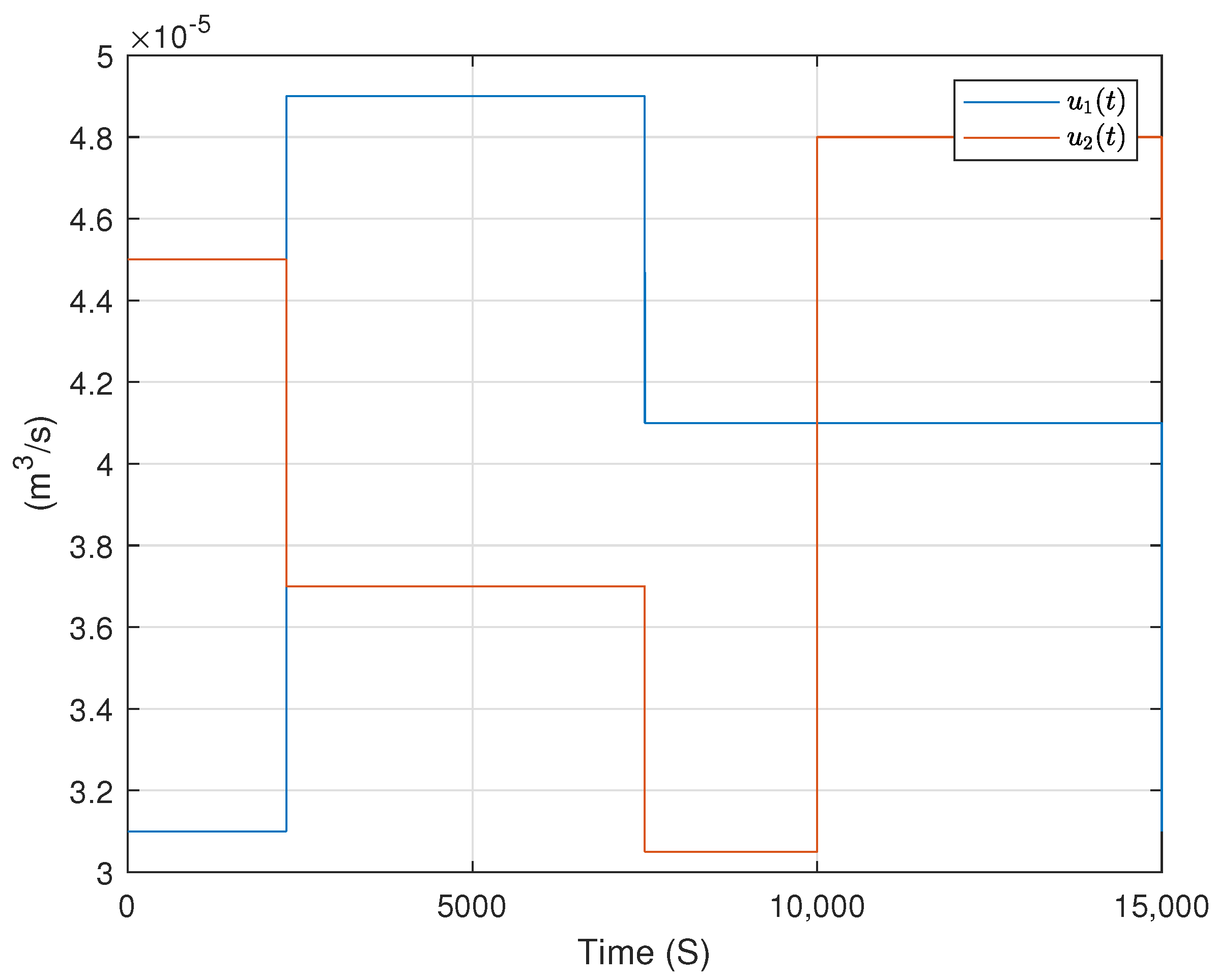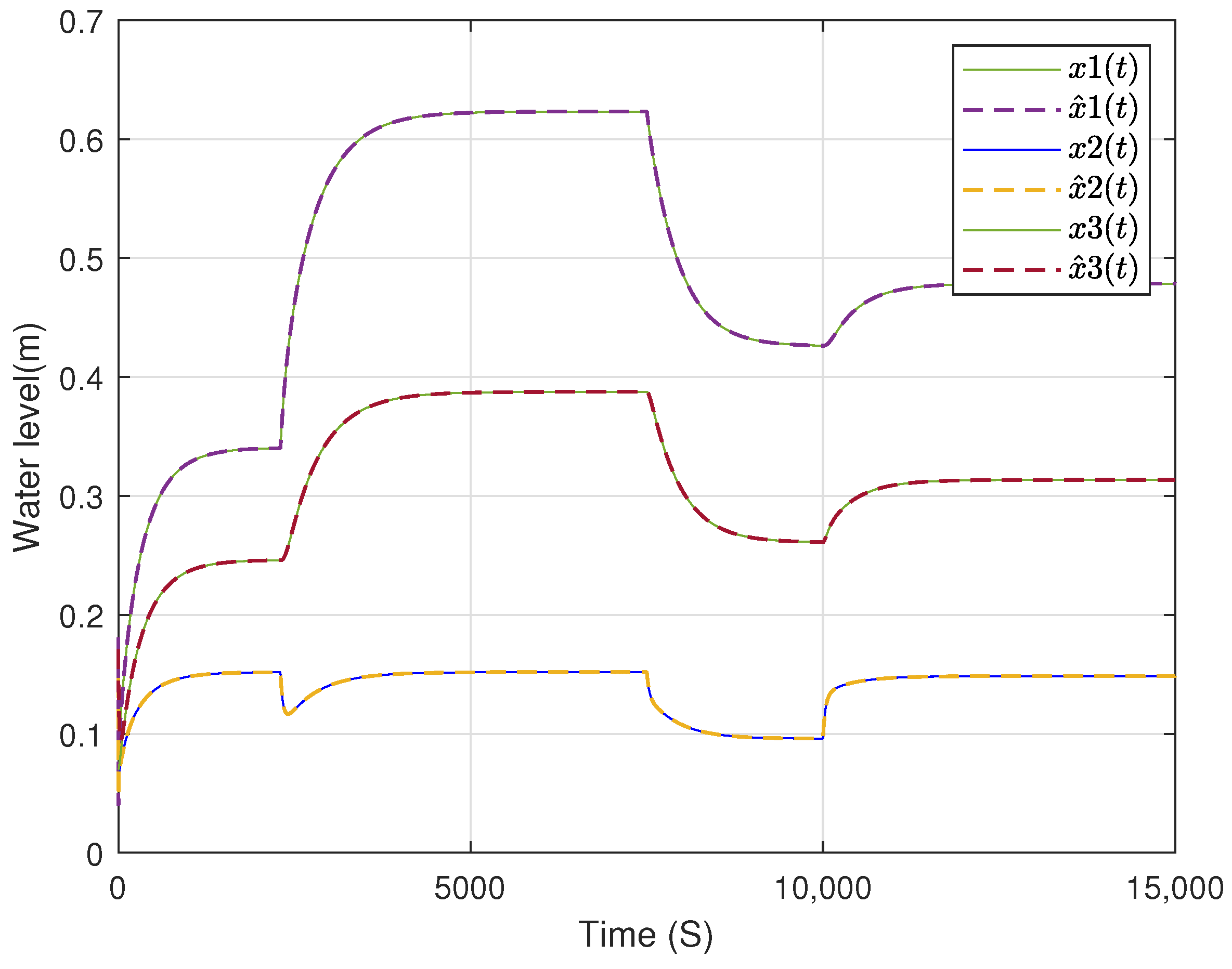Observer Design for Takagi–Sugeno Fuzzy Systems with Unmeasurable Premise Variables Based on Differential Mean Value Theorem †
Abstract
:1. Introduction
2. Preliminaries
2.1. Takagi–Sugeno Fuzzy Representation
2.2. Differential Mean Value Theorem [10]
3. Mean Value Theorem Observer-Based Design
4. Simulation Results
4.1. Dynamic Model of the System
4.2. Observer Design for Three-Tank Hydraulic System
4.3. Simulation Validation
5. Conclusions
Author Contributions
Funding
Institutional Review Board Statement
Informed Consent Statement
Data Availability Statement
Conflicts of Interest
References
- Luenberger, D. An introduction to observers. IEEE Trans. Autom. Control 1971, 16, 596–602. [Google Scholar] [CrossRef]
- Wang, Y.; Zou, L.; Ma, L.; Zhao, Z.; Guo, J. A survey on control for Takagi-Sugeno fuzzy systems subject to engineering-oriented complexities. Syst. Sci. Control. Eng. 2021, 9, 334–349. [Google Scholar] [CrossRef]
- Tanaka, K.; Wang, H.O. Fuzzy Control Systems Design and Analysis: A Linear Matrix Inequality Approach; John Wiley & Sons: New York, NY, USA, 2004. [Google Scholar]
- Louzimi, A.; El Assoudi, A.; Soulami, J.; El Yaagoubi, E. Unknown input observer design for a class of nonlinear descriptor systems: A Takagi-Sugeno approach with Lipschitz constraints. Nonlinear Anal. Differ. Equ. 2017, 5, 99–116. [Google Scholar] [CrossRef]
- Ouzaz, M.; El Assoudi, A. Simultaneous state and fault estimation for Takagi-Sugeno implicit models with Lipschitz constraints. Int. J. Optim. Control. Theor. Appl. 2021, 11, 100–108. [Google Scholar] [CrossRef]
- Boukhlouf, A.; Hammoudi, M.Y.; Saadi, R.; Benbouzid, M.E.H. Hardware-in-the-loop implementation of an unknown input observer for synchronous reluctance motor. ISA Trans. 2023, 133, 485–494. [Google Scholar] [CrossRef] [PubMed]
- Youssef, T.; Chadli, M.; Karimi, H.R.; Wang, R. Actuator and sensor faults estimation based on proportional integral observer for TS fuzzy mod. El. J. Frankl. Inst. 2017, 354, 2524–2542. [Google Scholar] [CrossRef]
- Pan, J.; Nguyen, A.T.; Guerra, T.M.; Sentouh, C.; Wang, S.; Popieul, J.C. Vehicle actuator fault detection with finite-frequency specifications via Takagi-Sugeno fuzzy observers: Theory and experiments. IEEE Trans. Veh. Technol. 2022, 72, 407–417. [Google Scholar] [CrossRef]
- Pan, J.; Nguyen, A.T.; Wang, S.; Deng, H.; Zhang, H. Fuzzy Unknown Input Observer for Estimating Sensor and Actuator Cyber-Attacks in Intelligent Connected Vehicles. Automot. Innov. 2023, 6, 164–175. [Google Scholar] [CrossRef]
- Zemouche, A.; Boutayeb, M.; Bara, G.I. Observers for a class of Lipschitz systems with extension to H∞ performance analysis. Syst. Control. Lett. 2008, 57, 18–27. [Google Scholar] [CrossRef]
- Ichalal, D.; Arioui, H.; Mammar, S. Observer design for two-wheeled vehicle: A Takagi-Sugeno approach with unmeasurable premise variables. In Proceedings of the 2011 19th Mediterranean Conference on Control & Automation (MED), Corfu, Greece, 20–23 June 2011; pp. 934–939. [Google Scholar]
- Phanomchoeng, G.; Rajamani, R.; Piyabongkarn, D. Nonlinear observer for bounded Jacobian systems, with applications to automotive slip angle estimation. IEEE Trans. Autom. Control 2011, 56, 1163–1170. [Google Scholar] [CrossRef]
- Mimoune, K.; Hammoudi, M.Y.; Saadi, R.; Benbouzid, M.; Boukhlouf, A. Real-Time Implementation of Non Linear Observer Based State Feedback Controller for Induction Motor Using Mean Value Theorem. J. Electr. Eng. Technol. 2023, 18, 615–628. [Google Scholar] [CrossRef]
- Allag, M.; Allag, A.; Zeghib, O.; Hamidani, B. Robust h∞ control based on the mean value theorem for induction motor drive. J. Control. Autom. Electr. Syst. 2019, 30, 657–665. [Google Scholar] [CrossRef]
- Hamidani, B.; Allag, A.; Allag, A.; Zeghib, O. Sensorless non-linear control applied to a PMSM machine based on new extended MVT observer. J. Electr. Eng. Technol. 2019, 14, 1615–1623. [Google Scholar] [CrossRef]
- Mimoune, K.; Hammoudi, M.Y.; Hamdi, W.; Mimoune, S.M. Observer design for Takagi–Sugeno fuzzy systems with unmeasured premise variables: Conservatism reduction using line integral Lyapunov function. ISA Trans. 2023, 142, 626–634. [Google Scholar] [CrossRef] [PubMed]
- Guzman, J.; López-Estrada, F.R.; Estrada-Manzo, V.; Valencia-Palomo, G. Actuator fault estimation based on a proportional-integral observer with nonquadratic Lyapunov functions. Int. J. Syst. Sci. 2021, 52, 1938–1951. [Google Scholar] [CrossRef]
- Ho, C.M.; Ahn, K.K. Adaptive Fuzzy Output Feedback Control Design for Pneumatic Active Suspension with Unknown Dead Zone. IEEE Access 2023, 11, 66858–66871. [Google Scholar] [CrossRef]




Disclaimer/Publisher’s Note: The statements, opinions and data contained in all publications are solely those of the individual author(s) and contributor(s) and not of MDPI and/or the editor(s). MDPI and/or the editor(s) disclaim responsibility for any injury to people or property resulting from any ideas, methods, instructions or products referred to in the content. |
© 2023 by the authors. Licensee MDPI, Basel, Switzerland. This article is an open access article distributed under the terms and conditions of the Creative Commons Attribution (CC BY) license (https://creativecommons.org/licenses/by/4.0/).
Share and Cite
Hamdi, W.; Hammoudi, M.Y.; Boukhlouf, A. Observer Design for Takagi–Sugeno Fuzzy Systems with Unmeasurable Premise Variables Based on Differential Mean Value Theorem. Eng. Proc. 2023, 58, 28. https://doi.org/10.3390/ecsa-10-16008
Hamdi W, Hammoudi MY, Boukhlouf A. Observer Design for Takagi–Sugeno Fuzzy Systems with Unmeasurable Premise Variables Based on Differential Mean Value Theorem. Engineering Proceedings. 2023; 58(1):28. https://doi.org/10.3390/ecsa-10-16008
Chicago/Turabian StyleHamdi, Wail, Mohamed Yacine Hammoudi, and Anouar Boukhlouf. 2023. "Observer Design for Takagi–Sugeno Fuzzy Systems with Unmeasurable Premise Variables Based on Differential Mean Value Theorem" Engineering Proceedings 58, no. 1: 28. https://doi.org/10.3390/ecsa-10-16008
APA StyleHamdi, W., Hammoudi, M. Y., & Boukhlouf, A. (2023). Observer Design for Takagi–Sugeno Fuzzy Systems with Unmeasurable Premise Variables Based on Differential Mean Value Theorem. Engineering Proceedings, 58(1), 28. https://doi.org/10.3390/ecsa-10-16008




